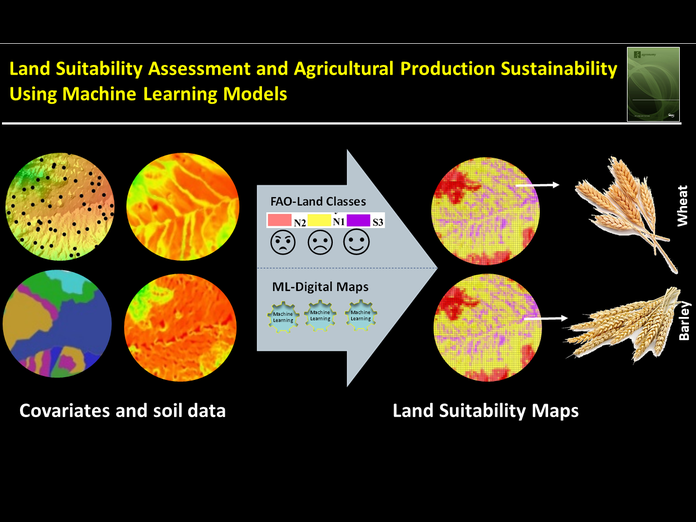19.01.2023
Land Suitability Assessment and Agricultural Production Sustainability Using Machine Learning Models
Food production depends on many factors. These include, for example, soil suitability, climate variability, and crop planning. Land suitability assessment is essential for increasing production and planning a sustainable agricultural system. Machine learning (ML) can improve the mapping of soil properties.
In the semi-arid regions of Iran, for example, such information is scarce. The aim of a study by Ruhollah Taghizadeh-Mehrjardi from the cluster group of Thomas Scholten and colleagues, published in the journal Agronomy, was to assess land suitability for two main crops, i.e., rain-fed wheat and barley, which are well adapted to rainfall conditions in western Iran. The article was selected a Editor's Choice.
Based on the "Land Suitability Classification" developed by the Food and Agriculture Organization of the United Nations (FAO), they developed a map of land suitability classes for an agricultural area of 65 km² in Kurdistan Province, Iran. In the first approach, the maps were created using ML models and auxiliary variables. In the second approach, the maps were created using the traditional approach, which is the most commonly used approach for creating land suitability class maps in Iran. Soil samples were collected from genetic layers of 100 soil profiles and the physical-chemical properties of the soil samples were analyzed. Topography and climate data were also recorded. After calculating the land suitability classes for the two crops, they were mapped using ML and traditional approaches.
The maps predicted by the two approaches revealed notable differences. For example, in the case of rain-fed wheat, results showed the higher accuracy of ML-based land suitability maps compared to the maps obtained by traditional approach. Furthermore, the findings indicated that the areas with classes of N2 (≈18%↑) and S3 (≈28%↑) were higher and area with the class N1 (≈24%↓) was less predicted in the traditional approach compared to the ML-based approach. The major limitations of the study area were rainfall at the flowering stage, severe slopes, shallow soil depth, high pH, and large gravel content.
Therefore, to increase production and create a sustainable agricultural system, land improvement operations are suggested.
Original publication: Ruhollah Taghizadeh-Mehrjardi, Kamal Nabiollahi, Leila Rasoli, Ruth Kerry and Thomas Scholten. Agronomy 2020, 10(4), 573; https://doi.org/10.3390/agronomy10040573
Further information on Ruhollah Taghizadeh's Website

